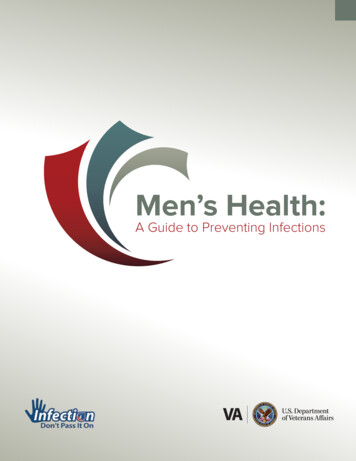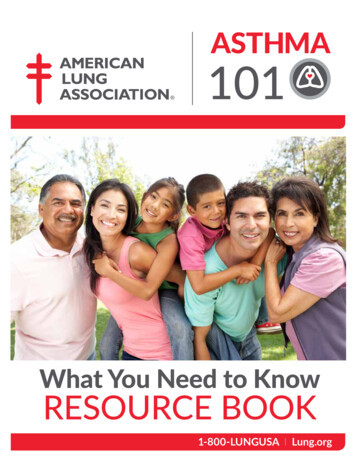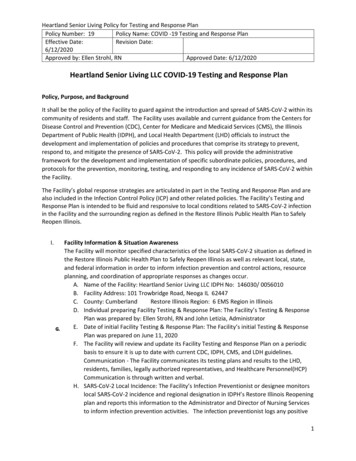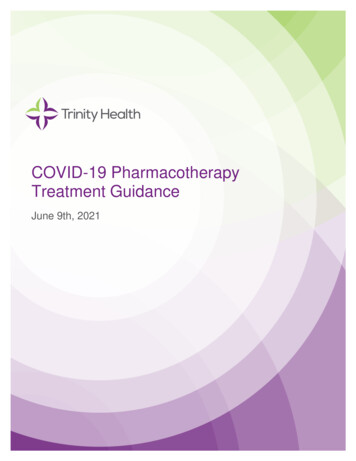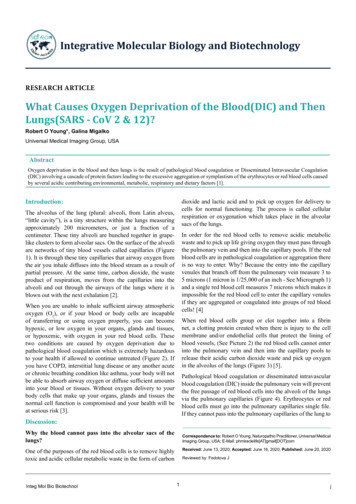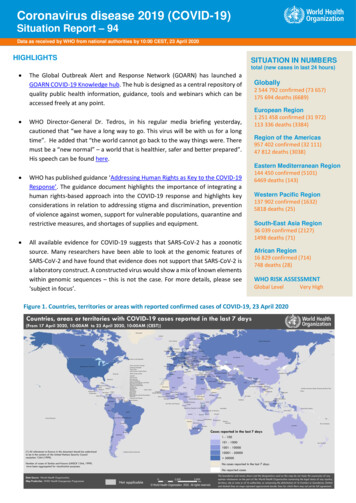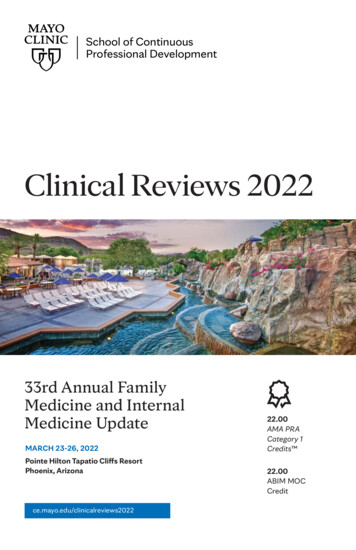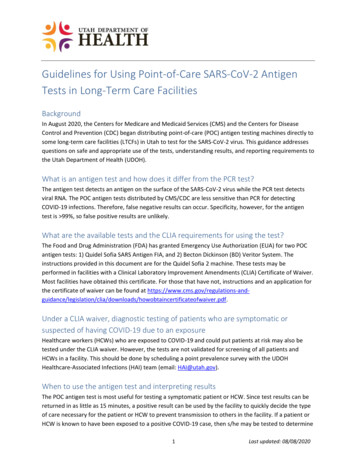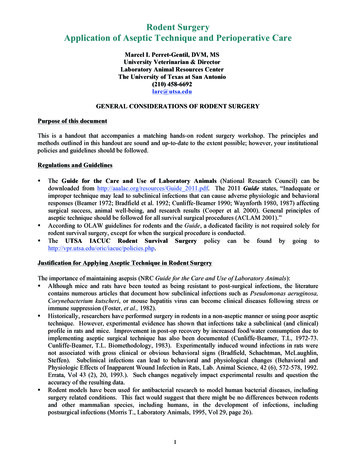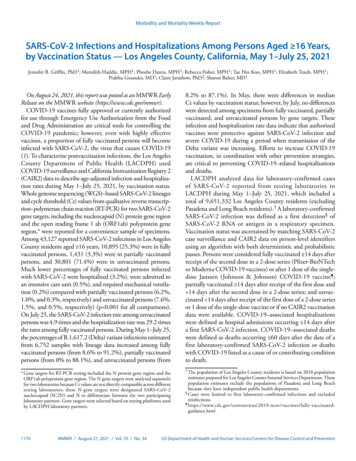
Transcription
Morbidity and Mortality Weekly ReportSARS-CoV-2 Infections and Hospitalizations Among Persons Aged 16 Years,by Vaccination Status — Los Angeles County, California, May 1–July 25, 2021Jennifer B. Griffin, PhD1; Meredith Haddix, MPH1; Phoebe Danza, MPH1; Rebecca Fisher, MPH1; Tae Hee Koo, MPH1; Elizabeth Traub, MPH1;Prabhu Gounder, MD1; Claire Jarashow, PhD2; Sharon Balter, MD1On August 24, 2021, this report was posted as an MMWR EarlyRelease on the MMWR website (https://www.cdc.gov/mmwr).COVID-19 vaccines fully approved or currently authorizedfor use through Emergency Use Authorization from the Foodand Drug Administration are critical tools for controlling theCOVID-19 pandemic; however, even with highly effectivevaccines, a proportion of fully vaccinated persons will becomeinfected with SARS-CoV-2, the virus that causes COVID-19(1). To characterize postvaccination infections, the Los AngelesCounty Department of Public Health (LACDPH) usedCOVID-19 surveillance and California Immunization Registry 2(CAIR2) data to describe age-adjusted infection and hospitalization rates during May 1–July 25, 2021, by vaccination status.Whole genome sequencing (WGS)–based SARS-CoV-2 lineagesand cycle threshold (Ct) values from qualitative reverse transcription–polymerase chain reaction (RT-PCR) for two SARS-CoV-2gene targets, including the nucleocapsid (N) protein gene regionand the open reading frame 1 ab (ORF1ab) polyprotein generegion,* were reported for a convenience sample of specimens.Among 43,127 reported SARS-CoV-2 infections in Los AngelesCounty residents aged 16 years, 10,895 (25.3%) were in fullyvaccinated persons, 1,431 (3.3%) were in partially vaccinatedpersons, and 30,801 (71.4%) were in unvaccinated persons.Much lower percentages of fully vaccinated persons infectedwith SARS-CoV-2 were hospitalized (3.2%), were admitted toan intensive care unit (0.5%), and required mechanical ventilation (0.2%) compared with partially vaccinated persons (6.2%,1.0%, and 0.3%, respectively) and unvaccinated persons (7.6%,1.5%, and 0.5%, respectively) (p 0.001 for all comparisons).On July 25, the SARS-CoV-2 infection rate among unvaccinatedpersons was 4.9 times and the hospitalization rate was 29.2 timesthe rates among fully vaccinated persons. During May 1–July 25,the percentages of B.1.617.2 (Delta) variant infections estimatedfrom 6,752 samples with lineage data increased among fullyvaccinated persons (from 8.6% to 91.2%), partially vaccinatedpersons (from 0% to 88.1%), and unvaccinated persons (from8.2% to 87.1%). In May, there were differences in medianCt values by vaccination status; however, by July, no differenceswere detected among specimens from fully vaccinated, partiallyvaccinated, and unvaccinated persons by gene targets. Theseinfection and hospitalization rate data indicate that authorizedvaccines were protective against SARS-CoV-2 infection andsevere COVID-19 during a period when transmission of theDelta variant was increasing. Efforts to increase COVID-19vaccination, in coordination with other prevention strategies,are critical to preventing COVID-19–related hospitalizationsand deaths.LACDPH analyzed data for laboratory-confirmed casesof SARS-CoV-2 reported from testing laboratories toLACDPH during May 1–July 25, 2021, which included atotal of 9,651,332 Los Angeles County residents (excludingPasadena and Long Beach residents).† A laboratory-confirmedSARS-CoV-2 infection was defined as a first detection§ ofSARS-CoV-2 RNA or antigen in a respiratory specimen.Vaccination status was ascertained by matching SARS-CoV-2case surveillance and CAIR2 data on person-level identifiersusing an algorithm with both deterministic and probabilisticpasses. Persons were considered fully vaccinated 14 days afterreceipt of the second dose in a 2-dose series (Pfizer-BioNTechor Moderna COVID-19 vaccines) or after 1 dose of the singledose Janssen (Johnson & Johnson) COVID-19 vaccine¶;partially vaccinated 14 days after receipt of the first dose and 14 days after the second dose in a 2-dose series; and unvaccinated 14 days after receipt of the first dose of a 2-dose seriesor 1 dose of the single-dose vaccine or if no CAIR2 vaccinationdata were available. COVID-19–associated hospitalizationswere defined as hospital admissions occurring 14 days aftera first SARS-CoV-2 infection. COVID-19–associated deathswere defined as deaths occurring 60 days after the date of afirst laboratory-confirmed SARS-CoV-2 infection or deathswith COVID-19 listed as a cause of or contributing conditionto death.* Gene targets for RT-PCR testing included the N protein gene region and theORF1ab polyprotein gene region. The N gene targets were analyzed separatelyfor two laboratories because Ct values are not directly comparable across differenttesting laboratories; these N gene targets were designated SARS-CoV-2nucleocapsid (SC2N) and N to differentiate between the two participatinglaboratory partners. Gene targets were selected based on testing platforms usedby LACDPH laboratory partners.† The population of Los Angeles County residents is based on 2018 population1170MMWR / August 27, 2021 / Vol. 70 / No. 34estimates prepared for Los Angeles County Internal Services Department. Thesepopulation estimates exclude the populations of Pasadena and Long Beachbecause they have independent public health departments.§ Cases were limited to first laboratory-confirmed infections and excludedreinfections.¶ /fully-vaccinatedguidance.htmlUS Department of Health and Human Services/Centers for Disease Control and Prevention
Morbidity and Mortality Weekly ReportDifferences in the percentages of infections by vaccinationstatus were calculated using chi-square tests for categoricalvariables and Kruskal-Wallis tests for medians; p-values 0.05were considered statistically significant. Age-adjusted rolling 7-day SARS-CoV-2 infection and hospitalization rateswere estimated by vaccination status.** Using conveniencesamples, WGS lineage data from all available sequencing results(6,752)†† and Ct values from diagnostic qualitative RT-PCRassays targeting two genes (SARS-CoV-2 nucleocapsid [SC2N;5,179], ORF1ab [1,041], and N [1,062]) from two laboratorieswere reported over time by vaccination status. Analyses wereconducted using SAS (version 9.4; SAS Institute). This activity was determined by LACDPH’s Institutional Review Board(IRB) to be a surveillance activity necessary for public healthwork and therefore did not require IRB review.The percentage of fully vaccinated Los Angeles County residents increased from 27% on May 1, 2021, to 51% on July 25,2021. During the same period, 43,127 cases of SARS-CoV-2infection among residents aged 16 years were reported toLACDPH, including 10,895 (25.3%) in fully vaccinatedpersons, 1,431 (3.3%) in partially vaccinated persons, and30,801 (71.4%) in unvaccinated persons (Table). The largest percentages of cases across all groups were among adultsaged 30–49 years and 18–29 years, females, and Hispanicpersons. Among fully vaccinated persons on July 25, 55.2%had received the Pfizer-BioNTech vaccine, 28.0% had receivedthe Moderna vaccine, and 16.8% had received the Janssenvaccine. Lower percentages of fully vaccinated persons werehospitalized (3.2%), were admitted to an intensive care unit(0.5%), and required mechanical ventilation (0.2%) comparedwith partially vaccinated persons (6.2%, 1.0%, and 0.3%,respectively) and unvaccinated persons (7.6%, 1.5%, and0.5%, respectively) (p 0.001). Among hospitalized personsand persons admitted to an intensive care unit, the medianage was higher among vaccinated persons (median 64 years,interquartile range [IQR] 53.0–76.0 years; median 64 years,IQR 54.0–76.0 years, respectively) and partially vaccinatedpersons (median 59, IQR 46.0–72.0; median 65,IQR 57.0–80.0, respectively) than among unvaccinatedpersons (median 49, IQR 35.0–62.0; median 56,IQR 41.0–66.0, respectively) (p 0.001). A lower percentageof fully vaccinated (1.2%) and partially vaccinated (2.0%)** Adjusted rates were calculated using 2018 population estimates and werestandardized using the year 2000 U.S. standard population (https://www.cdc.gov/cancer/uscs/technical notes/stat methods/rates.htm). Rolling 7-dayincidence was calculated by summing the total number of persons orhospitalizations during a 7-day period and dividing by the total populationat the end of the 7-day period.†† WGS lineage data were from all sequencing results reported to LACDPH orsequenced after specimens were referred to LACDPH laboratories.persons were admitted to a hospital after their SARS-CoV-2positive test result date compared with unvaccinated persons(4.2%). A lower percentage of deaths (0.2%, 24) occurredamong fully vaccinated persons than among partially vaccinated (0.5%, seven) and unvaccinated (0.6%, 176) persons(p 0.001). Death investigations determined that six of the 24fully vaccinated persons who died had immunocompromisingconditions, including HIV infection, cancer (i.e., prostate, pancreatic, lung, or leukemia), and liver transplantation, and thatthe median age was higher among vaccinated (median 78 years,IQR 63.5–87.5 years) and partially vaccinated (median 74,IQR 58.0–80.0) persons than among unvaccinated persons(median 63, IQR 51.5–79.5) (p 0.01).Among all Los Angeles County residents, the age-adjusted7-day incidence and hospitalization rates increased exponentially among unvaccinated, fully vaccinated, and partially vaccinated persons, with the highest rates among unvaccinatedpersons in late June (Figure 1). On May 1, in unvaccinated persons, the age-adjusted incidence (35.2 per 100,000 population)was 8.4 times and the age-adjusted hospitalization rate(4.6 per 100,000 population) was 10.0 times the rates infully vaccinated persons (4.2 and 0.46, respectively). Partiallyvaccinated persons had a similar incidence (4.1) and hospitalization rate (0.27) as fully vaccinated persons. On July 25,the age-adjusted incidence in unvaccinated persons (315.1)was 4.9 times that in fully vaccinated persons (63.8); the rateamong partially vaccinated persons was 46.8. The age-adjustedhospitalization rate in unvaccinated persons (29.4) was29.2 times the rate in fully vaccinated persons (1.0); the hospitalization rate was similar in partially vaccinated persons(0.90) (Supplementary Table; https://stacks.cdc.gov/view/cdc/109087).During May 1–July 25, the percentages of residents aged 16 years with SARS-CoV-2 Delta variant infections increasedfrom 8.6% to 91.2% in fully vaccinated persons (1,667), from0% to 88.1% in partially vaccinated persons (198), and from8.2% to 87.1% in unvaccinated persons (4,887) (Figure 2).In May, median Ct values were lower in specimens from unvaccinated persons than in those from partially vaccinated andfully vaccinated persons for the ORF1ab gene target (22.8,36.6, and 27.7, respectively) and N gene target (24.0, 36.0, and30.6, respectively); however, in July, no differences were foundby vaccination status among the gene targets (SC2N 19.3,20.2, and 19.4; ORF1ab 18.8, 17.8, and 19.0; N 19.3,18.6, and 19.5, respectively) (Figure 2).US Department of Health and Human Services/Centers for Disease Control and PreventionMMWR / August 27, 2021 / Vol. 70 / No. 341171
Morbidity and Mortality Weekly ReportTABLE. Number of SARS-CoV-2 cases among persons aged 16 years, by selected characteristics and vaccination status* — Los Angeles County,California,† May 1–July 25, 2021Vaccination status, no. (%)CharacteristicTotalFully vaccinatedTotal no. of casesVaccine manufacturerJanssen (Johnson & Johnson)ModernaPfizer-BioNTechMedian interval between final vaccine dose andinfection, no. of days (IQR)Median age, yrs (IQR)Age group, yrs16–1718–2930–4950–6465–79 80SexFemaleMaleOther or unknownRace/EthnicityAmerican Indian or Alaska NativeAsianBlack or African AmericanHispanic or LatinoMultiple raceNative Hawaiian or Other Pacific IslanderOtherWhiteMissingHospitalizedAdmitted to ICURequired mechanical ventilationAdmitted to hospital after positive SARS-CoV-2test dateDied43,12710,895Partially ��—1,830 (16.8)3,047 (28.0)6,018 (55.2)98 (74–120)————————————34 (26–46)37 (28–52)35 (27–51)32 (26–44) 0.0011,120 (2.6)14,758 (34.2)18,106 (42.0)6,418 (14.9)2,101 (4.9)624 (1.4)107 (1.0)3,017 (27.7)4,649 (42.7)2,025 (18.6)857 (7.9)240 (2.2)34 (2.4)432 (30.2)582 (40.7)255 (17.8)95 (6.6)33 (2.3)979 (3.2)11,309 (36.7)12,875 (41.8)4,138 (13.4)1,149 (3.7)351 (1.1) 0.00121,743 (50.4)20,425 (47.4)959 (2.2)5,514 (50.6)5,249 (48.2)132 (1.2)757 (52.9)659 (46.1)15 (1.0)15,472 (50.2)14,517 (47.1)812 (2.6) 0.00170 (0.2)1,970 (4.6)5,574 (12.9)14,144 (32.8)823 (1.9)210 (0.5)3,998 (9.3)9,338 (21.7)7,000 (16.2)2,794 (6.5)536 (1.2)189 (0.4)1,454 (3.4)17 (0.2)905 (8.3)681 (6.3)3,450 (31.7)272 (2.5)41 (0.4)778 (7.1)3,397 (31.2)1,354 (12.4)350 (3.2)55 (0.5)19 (0.2)136 (1.2)2 (0.1)104 (7.3)138 (9.6)511 (35.7)32 (2.2)8 (0.6)112 (7.8)321 (22.4)203 (14.2)89 (6.2)15 (1.0)5 (0.3)29 (2.0)51 (0.2)961 (3.1)4,755 (15.4)10,183 (33.1)519 (1.7)161 (0.5)3,108 (10.1)5,620 (18.2)5,443 (17.7)2,355 (7.6)466 (1.5)165 (0.5)1,289 (4.2) 0.001207 (0.5)24 (0.2)7 (0.5)176 (0.6) 0.001 0.001 0.001 0.001 0.001Abbreviations: ICU intensive care unit; IQR interquartile range.* Persons were considered fully vaccinated 14 days after receipt of the second dose in a 2-dose series (Pfizer-BioNTech or Moderna COVID-19 vaccines) or after 1 doseof the single-dose Janssen (Johnson & Johnson) COVID-19 vaccine; partially vaccinated 14 days after receipt of the first dose and 14 days after the second dosein a 2-dose series; and unvaccinated 14 days receipt of the first dose of a 2-dose series or 1 dose of the single-dose vaccine or if no vaccination registry datawere available.† Among residents of Los Angeles County; excludes Pasadena and Long Beach.DiscussionThe results of this population-based analysis using linkedSARS-CoV-2 infection surveillance and vaccination registrydata indicate that fully vaccinated persons aged 16 years withSARS-CoV-2 infection were less likely than unvaccinatedpersons to be hospitalized, to be admitted to an intensivecare unit, to require mechanical ventilation, or to die fromSARS-CoV-2 infection during a period when the Delta variantbecame predominant. Although age-adjusted hospitalizationrates in partially vaccinated persons were similar to those infully vaccinated persons, age-adjusted incidences were slightlylower in partially vaccinated persons than in fully vaccinatedpersons. These data indicate that authorized vaccines protect1172MMWR / August 27, 2021 / Vol. 70 / No. 34against SARS-CoV-2 infection and severe COVID-19, evenwith increased community transmission of the newly predominant Delta variant (2).The SARS-CoV-2 Delta variant is highly transmissible (3)and became the predominant variant in Los Angeles Countyduring May–July 2021. During this period, SARS-CoV-2cases and hospitalizations increased substantially, most notably among unvaccinated persons. In May, specimens fromfully vaccinated and partially vaccinated persons had higherCt values for two gene targets compared with unvaccinatedpersons; however, by July, median Ct values had decreasedand were similar in all gene regions in specimens from fullyvaccinated, partially vaccinated, and unvaccinated persons.US Department of Health and Human Services/Centers for Disease Control and Prevention
Morbidity and Mortality Weekly ReportFIGURE 1. Age-adjusted rolling 7-day SARS-CoV-2 infection andhospitalization rates,* by vaccination status† — Los Angeles County,California, May 1–July 25, 2021No. of cases per 100,000350Although COVID-19 vaccines are highly effective, some fullyvaccinated persons will be infected with SARS-CoV-2.Age-adjusted rolling 7-day SARS-CoV-2 infection ratesWhat is added by this report?UnvaccinatedPartially vaccinatedFully vaccinated300250During May 1–July 25, 2021, among 43,127 SARS-CoV-2infections in residents of Los Angeles County, California,10,895 (25.3%) were in fully vaccinated persons, 1,431 (3.3%)were in partially vaccinated persons, and 30,801 (71.4%) were inunvaccinated persons. On July 25, infection and hospitalizationrates among unvaccinated persons were 4.9 and 29.2 times,respectively, those in fully vaccinated persons. In July, whenthe Delta variant was predominant, cycle threshold valueswere similar for unvaccinated, partially vaccinated, andvaccinated persons.2001501005001815 22May29512 19Jun26310 17Jul24No. of hospitalizations per 100,000Age-adjusted rolling 7-day hospitalization ratesUnvaccinatedPartially vaccinatedFully vaccinated3025201510501815 22May29512 19Jun26310 17Jul24Week* Rolling 7-day incidence was calculated by summing the total number ofpersons or hospitalizations during a 7-day period and dividing by the totalpopulation at the end of the 7-day period.† Persons were considered fully vaccinated 14 days after receipt of thesecond dose in a 2-dose series (Pfizer-BioNTech or Moderna COVID-19 vaccines)or after 1 dose of the single-dose Janssen (Johnson & Johnson) COVID-19vaccine; partially vaccinated 14 days after receipt of the first dose and 14 days after the second dose in a 2-dose series; and unvaccinated 14 daysreceipt of the first dose of a 2-dose series or 1 dose of the single-dose vaccineor if no vaccination registry data were available.These findings are similar to those from a recent study showingno difference in Ct values in specimens from vaccinated andunvaccinated persons during a large outbreak (4). Ct valuesare correlated with the amount of viral nucleic acid present;however, Ct values are an imperfect proxy for viral nucleicacid load, are not standardized across testing platforms, vary§§What are the implications for public health practice?Efforts to enhance COVID-19 vaccination coverage, in coordination with other prevention strategies, are critical to preventingCOVID-19–related hospitalizations and deaths.Week35SummaryWhat is already known about this topic?Additional information on Ct values and their limitations is available: -health/covid-19/idsa-ampstatement.pdf and .html.by specimen type and time from specimen collection, andshould be limited to assessing differences at the populationlevel, not the person level.§§The findings in this report are subject to at least sixlimitations. First, vaccination data for persons who lived inLos Angeles County at the time of their laboratory-confirmedinfection but who were vaccinated outside of California wereunavailable, leading to misclassification of their vaccinationstatus; if vaccinated persons without accessible records wereconsidered to be unvaccinated, the incidence in unvaccinatedpersons could be underestimated. Second, case ascertainmentis based on passive surveillance, with known underreportingthat might differ by vaccination status. Similarly, screeningand testing behaviors might differ among groups. Third,COVID-19–associated hospitalizations were determined basedon hospital admission and SARS-CoV-2 test dates alone, leading to the inclusion of incidental hospitalizations that were notassociated with COVID-19. Fourth, COVID-19–associateddeaths included deaths occurring 60 days after a firstSARS-CoV-2 positive test date; therefore, some COVID-19–associated deaths might have been from other causes (excludingtrauma). In addition, certain COVID-19–associated deathsmight have been a result of long-term sequelae after 60 days andwere not included. Fifth, lineage and Ct values were availableonly for a convenience sample of SARS-CoV-2 cases. Finally,all the assays used to generate Ct values for comparison werequalitative, and none is approved for use in quantitating theamount of viral nucleic acid present.The findings in this report are similar to those fromrecent studies indicating that COVID-19 vaccinationUS Department of Health and Human Services/Centers for Disease Control and PreventionMMWR / August 27, 2021 / Vol. 70 / No. 341173
Morbidity and Mortality Weekly ReportFIGURE 2. SARS-CoV-2 whole genome sequencing lineage results* and reverse transcription–polymerase chain reaction cycle threshold values†for two gene targets,§ by vaccination status¶ and month — Los Angeles County, California, May 1–July 25, 2021Whole genome sequencing lineage results100Gamma (P.1)OtherDelta (B.1.617.2)Alpha PartiallyvaccinatedFullyUnvaccinated PartiallyvaccinatedvaccinatedMayFullyUnvaccinated lyVaccination status and monthSee footnotes on the next page.protects against severe COVID-19 in areas with increasingprevalence of the SARS-CoV-2 Delta variant (5,6). Effortsto increase COVID-19 vaccination coverage, in coordinationwith other prevention strategies, are critical to preventingCOVID-19–related hospitalizations and deaths. Ongoingsurveillance to characterize postvaccination infections, hospitalizations, and deaths will be important to monitor vaccineeffectiveness, particularly as new variants emerge.AcknowledgmentsKelsey Oyong; Heidi Sato; Rebecca Lee; Mireille Ibrahim;Kathleen Poortinga; Mirna Ponce-Jewell; Dulmini Wilson;Emmanuel Mendoza.1174MMWR / August 27, 2021 / Vol. 70 / No. 34Corresponding author: Sharon Balter, sbalter@ph.lacounty.gov.1Acute Communicable Disease Control Program, Los Angeles CountyDepartment of Public Health, California; 2Vaccine Preventable Disease ControlProgram, Los Angeles County Department of Public Health, California.All authors have completed and submitted the InternationalCommittee of Medical Journal Editors form for disclosure of potentialconflicts of interest. M. Claire Jarashow reports consulting fees fromUber outside the current work and unpaid board membership of twointernational nongovernmental organizations (C2C and DevelopingCommunities) outside the current work. No other potential conflictsof interest were disclosed.US Department of Health and Human Services/Centers for Disease Control and Prevention
Morbidity and Mortality Weekly ReportFIGURE 2. (Continued) SARS-CoV-2 whole genome sequencing lineage results* and reverse transcription–polymerase chain reaction cyclethreshold values† for two gene targets,§ by vaccination status¶ and month — Los Angeles County, California, May 1–July 25, 2021RT-PCR Ct values504540SC2N Ct35Fully vaccinatedPartially 545404035353030N CtORF1ab CtMonth252015105025201510Fully vaccinatedPartially vaccinatedUnvaccinatedMay5JuneJulyMonth0Fully vaccinatedPartially s: Ct cycle threshold; N nucleocapsid; ORF1ab open reading frame 1 ab; RT-PCR reverse transcription–polymerase chain reaction;SC2N SARS-CoV-2 nucleocapsid.* SARS-CoV-2 infections among Los Angeles County residents aged 16 years with whole genome sequencing lineage results (n 6,752) for fully vaccinated (n 1,667),partially vaccinated (n 198), and unvaccinated (n 4,887) persons.† Whiskers represent minimum and maximum observations; top of box represents the third quartile, bottom represents the first quartile, and box height representsthe interquartile range. The midline is the median.§ Ct values are correlated with the amount of viral nucleic acid present. Gene targets for RT-PCR testing included the N protein gene region and the ORF1ab polyproteingene region. The N gene targets were analyzed separately for two laboratories because Ct values are not directly comparable across different testing laboratories;these N gene targets were designated SC2N and N to differentiate between the two participating laboratory partners. Gene targets were selected based on testingplatforms used by Los Angeles County Department of Public Health laboratory partners. Analysis of SC2N Ct values is restricted to a Fulgent test result with a Ctvalue on the same day as person’s first positive RT-PCR test result; SC2N gene target values (n 5,179) are stratified for fully vaccinated (n 1,248), partially vaccinated(n 151), and unvaccinated (n 3,780) persons. Analysis of ORF1ab and N Ct values is restricted to a Valencia Branch Laboratory test result with a Ct value on thesame day as person’s first positive RT-PCR test result. ORF1ab (n 1,041) and N (n 1,062) gene target values are stratified for fully vaccinated (n 289 and n 297,respectively), partially vaccinated (n 36 and n 41, respectively), and unvaccinated (n 716 and n 724, respectively) persons.¶ Persons were considered fully vaccinated 14 days after receipt of the second dose in a 2-dose series (Pfizer-BioNTech or Moderna COVID-19 vaccines) or after 1 doseof the single-dose Janssen (Johnson & Johnson) COVID-19 vaccine; partially vaccinated 14 days after receipt of the first dose and 14 days after the second dose in a2-dose series; and unvaccinated 14 days receipt of the first dose of a 2-dose series or 1 dose of the single-dose vaccine or if no vaccination registry data were available.US Department of Health and Human Services/Centers for Disease Control and PreventionMMWR / August 27, 2021 / Vol. 70 / No. 341175
Morbidity and Mortality Weekly ReportReferences1. Birhane M, Bressler S, Chang G, et al.; CDC COVID-19 VaccineBreakthrough Case Investigations Team. COVID-19 vaccine breakthroughinfections reported to CDC—United States, January 1–April 30, 2021.MMWR Morb Mortal Wkly Rep 2021;70:792–3. 32. Lopez Bernal J, Andrews N, Gower C, et al. Effectiveness of Covid19 vaccines against the B.1.617.2 (Delta) variant. N Engl J Med2021;385:585–94. PMID:34289274 https://doi.org/10.1056/NEJMoa21088913. Allen H, Vusirikala A, Flannagan J, et al.; Public Health England.Increased household transmission of COVID-19 cases associated withSARS-CoV-2 variant of concern B.1.617.2: a national case-controlstudy. Knowledge Hub [Preprint posted online June 18, 50/Increased Household Transmission of COVID-19 Cases - national case MMWR / August 27, 2021 / Vol. 70 / No. 344. Brown CM, Vostok J, Johnson H, et al. Outbreak of SARS-CoV-2 infections,including COVID-19 vaccine breakthrough infections, associated withlarge public gatherings—Barnstable County, Massachusetts, July 2021.MMWR Morb Mortal Wkly Rep 2021;70:1059–62. 25. Nasreen S, He S, Chung H, et al. Effectiveness of COVID-19 vaccinesagainst variants of concern, Canada [Preprint posted online July 16, .06.28.21259420v26. Sheikh A, McMenamin J, Taylor B, Robertson C; Public Health Scotlandand the EAVE II Collaborators. SARS-CoV-2 Delta VOC in Scotland:demographics, risk of hospital admission, and vaccine effectiveness.Lancet 2021;397:2461–2. PMID:34139198 https://doi.org/10.1016/S0140-6736(21)01358-1US Department of Health and Human Services/Centers for Disease Control and Prevention
8.2% to 87.1% in unvaccinated persons (4,887) (Figure 2). In May, median Ct values were lower in specimens from unvac - cinated persons than in those from partially vaccinated and fully vaccinated persons for the ORF1ab gene target (22.8, 36.6, a

